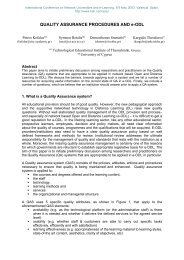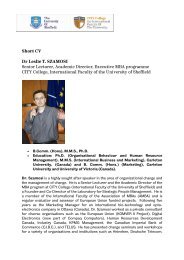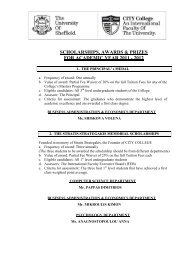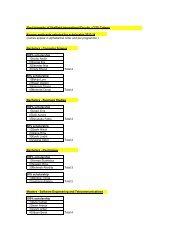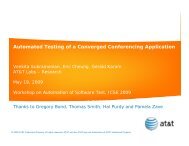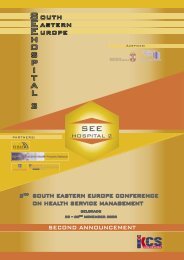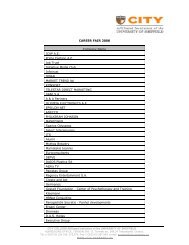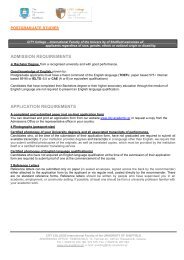Optimising development and deployment of ... - ResearchGate
Optimising development and deployment of ... - ResearchGate
Optimising development and deployment of ... - ResearchGate
You also want an ePaper? Increase the reach of your titles
YUMPU automatically turns print PDFs into web optimized ePapers that Google loves.
2<br />
provider’s end. PaaS <strong>of</strong>ferings are appealing to a wide range <strong>of</strong> types <strong>of</strong> s<strong>of</strong>tware<br />
developers, such as Independent S<strong>of</strong>tware Vendors (ISVs), Value-Added Resellers<br />
(VARs), System Integrators, but also in-house IT teams [1]. The model is<br />
theoretically applicable to applications <strong>and</strong> solutions irrespective <strong>of</strong> size or domain,<br />
but in practice, it appears to have gained widespread adoption especially in the<br />
context <strong>of</strong> enterprise s<strong>of</strong>tware applications [2], primarily due to their inherent<br />
database-centric nature.<br />
Apart from the benefits that the model <strong>of</strong> PaaS brings for s<strong>of</strong>tware developers, it<br />
also carries a great number <strong>of</strong> benefits for prospective PaaS providers. Most<br />
importantly, it ultimately enables platform providers to pursue the creation <strong>of</strong> valueadded<br />
networks <strong>and</strong> the <strong>development</strong> <strong>of</strong> entire business ecosystems around their<br />
platforms, in an analogy to the way current mobile phone platforms like iPhone,<br />
Android <strong>and</strong> Blackberry are operating. This, however, remains largely a vision for the<br />
time being. With a few exceptions (e.g. force.com [3]), the majority <strong>of</strong> today’s PaaS<br />
providers lack the required technical facilities to support this concept to its full extent.<br />
The reason is that the design <strong>of</strong> mature platforms to support this model in an effective<br />
fashion is a particularly complex <strong>and</strong> challenging undertaking for PaaS providers.<br />
CAST is an ongoing research project 1 that is investigating the challenges<br />
associated with this vision <strong>and</strong> aims to develop a commercial platform that can fulfil<br />
this objective. The project is seeking to define an approach for the design <strong>of</strong> a<br />
platform that pushes the envelope <strong>of</strong> configurability <strong>and</strong> customisability, ecosystemcentric<br />
extensibility <strong>and</strong> native multi-tenancy. In the rest <strong>of</strong> this paper we discuss the<br />
key challenges associated with the design <strong>of</strong> such a platform, briefly review the state<br />
<strong>of</strong> practice in the area <strong>of</strong> PaaS <strong>of</strong>ferings relative to those challenges, <strong>and</strong> provide an<br />
overview <strong>of</strong> the CAST platform’s main concepts <strong>and</strong> architecture.<br />
2 Platform maturity levels <strong>and</strong> the state <strong>of</strong> practice<br />
The technology space for PaaS <strong>of</strong>ferings is currently evolving <strong>and</strong> undergoing<br />
changes as it progresses towards higher levels <strong>of</strong> maturity. As usually happens with<br />
concepts that gain wide acceptance before they are fully analysed <strong>and</strong> understood, the<br />
term PaaS has become rather overloaded. Broadly speaking, we can categorise the<br />
PaaS <strong>of</strong>ferings available today in two basic types: technology-specific PaaS, such as<br />
Google App Engine, Micros<strong>of</strong>t Azure, Heroku <strong>and</strong> Engine Yard, <strong>and</strong> domain-specific<br />
PaaS, such as Force.com, LongJump, Zoho Creator <strong>and</strong> WOLF.<br />
Despite the widespread adoption <strong>of</strong> PaaS as a model, it might not be an<br />
exaggeration to claim that, at the moment, only a few <strong>of</strong> the technology providers that<br />
categorise themselves under ‘PaaS’ are actually supporting the concept <strong>of</strong> PaaS to its<br />
full extent, i.e. work with a vision to achieve a true “s<strong>of</strong>tware platform effect” [4] <strong>and</strong><br />
to support the creation <strong>of</strong> actual ecosystems around their <strong>of</strong>ferings.<br />
To facilitate comparison between the multitude <strong>of</strong> <strong>of</strong>ferings <strong>and</strong> supporting<br />
platforms for SaaS/PaaS that are available on the market, attempts have been made to<br />
1<br />
http://www.cast-project.eu




